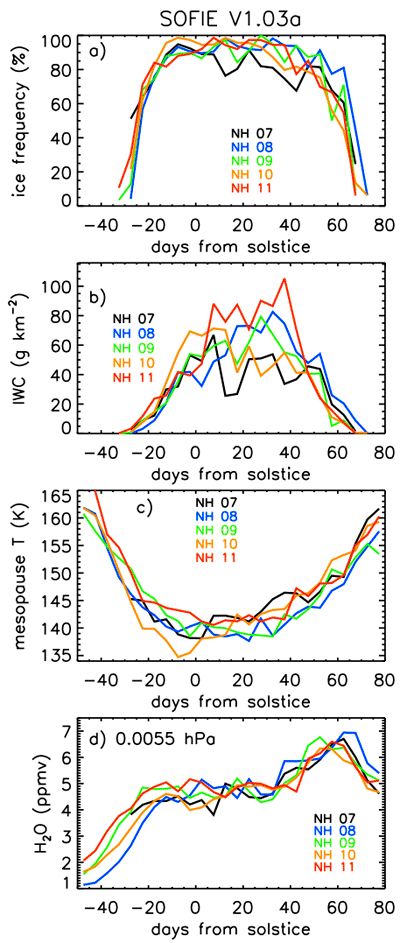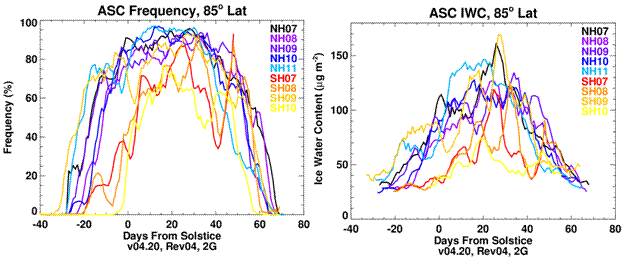|
STATUS:
09.24.11
Spacecraft Status
The AIM spacecraft continues to operate well with limited periods of bitlock. Over the past few months we performed CIPS Northern Hemisphere Fast Cadence Flat Field calibration imaging. We also updated the on-board CIPS autonomy sequences to provide better performance as the orbit slowly decays.
Instrument Status
The SOFIE instrument continues to operate nominally. With the Northern Hemisphere of 2011, AIM has completed its 9th PMC season. The figure below shows time series for five Northern seasons of a) ice frequency, b) ice water content (IWC), c) mesopause temperature, and d) water vapor at the average PMC peak pressure. The 2011 season is marked by the earliest onset of PMCs and the highest IWC observed to date. The early onset of PMCs in 2011 is related to relatively high water vapor during early season, despite relatively warm temperatures. The relatively high IWC during mid-season 2011 is somewhat of a conundrum, because the mesopause temperatures are relatively warm and the mid-season water vapor is similar when compared to other years. These differences suggest that factors in addition to temperature and water vapor are important in controlling PMC IWC.

CIPS continues to perform well, with no health issues. We are working on the release of a new revision of version 4.20 (rev 05). This data product will have only minor differences relative to rev 04, which is the currently available data set. The primary reasons for the new revision are to add attributes and dates to the level 2 netcdf files, remove duplicate arrays in the level 2 files, make sure that all level 2 arrays have consistent NaN values, add orbit numbers to the petals of the level 3a png plots and change the low-SZA cut-off 42° instead of 40°, add a color bar to the level 2 albedo png plots, introduce new level 2 png plots of the ice water content and radius, change the high-radius cutoff of the retrievals to 100 nm instead of 101 nm, and correct a longitude error that affected some of the png plots. The rev 05 processing will begin in early October.
The plots below show the daily frequencies (left) and average ice water content (right) measured by CIPS at a latitude of 85° for all seasons thus far observed by AIM. The NH11 season was generally similar to other seasons, but showed higher frequencies and ice water content around days 0-20 after solstice. There were also fewer clouds than in other NH seasons near days 40-60 after solstice. Whether this is consistent with the temperatures and water vapor at the CIPS measurements latitudes is under investigation.

|
